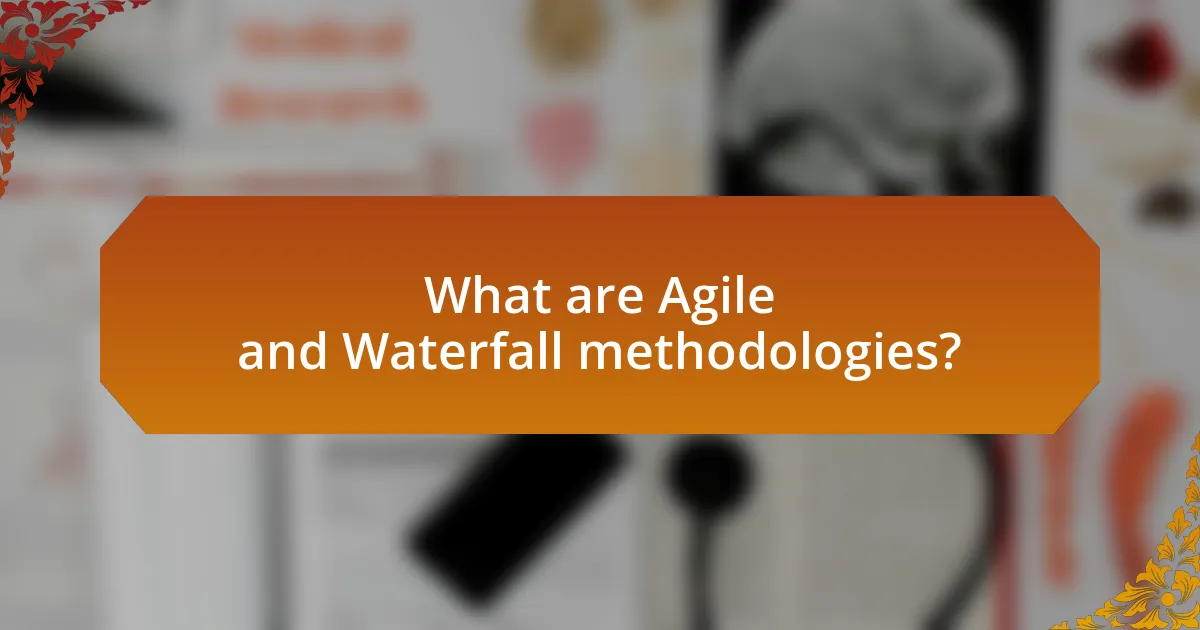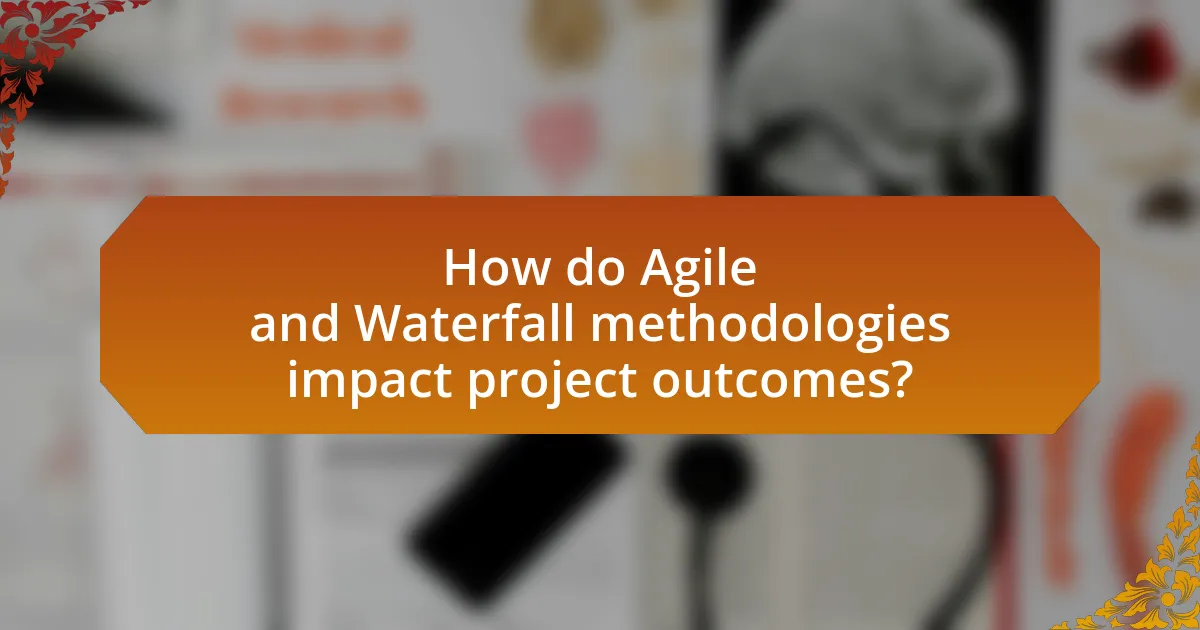Agile and Waterfall are two prominent software development methodologies, each with distinct characteristics and applications. Agile is an iterative approach that prioritizes flexibility, collaboration, and customer feedback, making it suitable for dynamic projects with evolving requirements. In contrast, Waterfall follows a linear and sequential model, emphasizing thorough documentation and structured phases, which is effective for projects with well-defined requirements. This article provides a comparative analysis of both methodologies, exploring their key principles, historical contexts, advantages, disadvantages, and the impact they have on project outcomes, ultimately guiding teams in selecting the appropriate approach based on project needs.

What are Agile and Waterfall methodologies?
Agile and Waterfall are two distinct software development methodologies. Agile is an iterative approach that emphasizes flexibility, collaboration, and customer feedback, allowing teams to adapt to changes throughout the development process. In contrast, Waterfall is a linear and sequential model where each phase must be completed before moving to the next, making it less adaptable to changes once the project is underway. The Agile methodology is supported by frameworks such as Scrum and Kanban, which facilitate continuous improvement and responsiveness, while Waterfall is often used in projects with well-defined requirements and low uncertainty, such as construction or manufacturing.
How do Agile and Waterfall differ in their approach to software development?
Agile and Waterfall differ fundamentally in their approach to software development, with Agile emphasizing iterative progress and flexibility, while Waterfall follows a linear and sequential process. Agile allows for continuous feedback and adaptation throughout the development cycle, enabling teams to respond to changes quickly, which is particularly beneficial in dynamic environments. In contrast, Waterfall requires a complete and detailed project plan upfront, with each phase dependent on the completion of the previous one, making it less adaptable to changes once the project is underway. This distinction is supported by the fact that Agile methodologies, such as Scrum and Kanban, have been shown to improve project success rates by fostering collaboration and responsiveness, while Waterfall is often criticized for its rigidity and potential for increased project risk if initial requirements are misunderstood.
What are the key principles of Agile methodology?
The key principles of Agile methodology include customer satisfaction through early and continuous delivery of valuable software, welcoming changing requirements even late in development, delivering working software frequently, and promoting collaboration between business stakeholders and developers. Agile emphasizes motivated individuals, face-to-face communication, and sustainable development, ensuring that teams maintain a constant pace. Continuous attention to technical excellence and good design enhances agility, while simplicity is essential for maximizing the amount of work not done. Regular reflection and adjustment of behavior are also crucial for improving team effectiveness. These principles are outlined in the Agile Manifesto, which was created in 2001 by a group of software developers seeking to improve software development practices.
What are the key principles of Waterfall methodology?
The key principles of Waterfall methodology include a linear and sequential approach to software development, where each phase must be completed before the next begins. This methodology emphasizes thorough documentation, clear requirements, and a structured process that typically consists of stages such as requirements analysis, system design, implementation, testing, deployment, and maintenance. Each phase has specific deliverables and a review process, ensuring that the project adheres to its initial specifications. The Waterfall model is particularly effective for projects with well-defined requirements and minimal expected changes, as it allows for easier management and tracking of progress.
What are the historical contexts of Agile and Waterfall methodologies?
The historical context of Agile and Waterfall methodologies reveals distinct origins and developments in software engineering. Waterfall methodology emerged in the 1970s, formalized by Winston W. Royce in a 1970 paper, where he described a linear and sequential approach to software development, emphasizing the importance of completing each phase before moving to the next. This model became widely adopted due to its structured nature, particularly in large-scale projects.
In contrast, Agile methodology originated in the early 2000s, with the Agile Manifesto published in 2001 by a group of software developers, including Kent Beck and Martin Fowler. Agile arose as a response to the limitations of Waterfall, promoting iterative development, collaboration, and flexibility to adapt to changing requirements. The historical shift from Waterfall to Agile reflects the evolving needs of software development, emphasizing speed and adaptability in a rapidly changing technological landscape.
How did Agile methodology emerge in the software development landscape?
Agile methodology emerged in the software development landscape as a response to the limitations of traditional project management approaches, particularly the Waterfall model. In the early 2000s, a group of software developers created the Agile Manifesto, which emphasized values such as collaboration, flexibility, and customer feedback over rigid planning and documentation. This shift was driven by the need for faster delivery of software and the ability to adapt to changing requirements, which were often not addressed effectively by the Waterfall model. The Agile Manifesto, published in 2001, outlined 12 principles that further solidified Agile practices, leading to widespread adoption across various industries.
What historical events led to the development of the Waterfall model?
The development of the Waterfall model was primarily influenced by the publication of the “Waterfall” concept in 1970 by Dr. Winston W. Royce, who presented it in a paper titled “Managing the Development of Large Software Systems.” This model emerged as a response to the challenges faced in software engineering during the 1960s, where projects often suffered from poor planning and lack of structured methodologies. Royce’s paper outlined a sequential design process that emphasized the importance of thorough documentation and clear phases, including requirements analysis, design, implementation, testing, and maintenance. The Waterfall model gained further traction in the 1980s as software development became more complex, necessitating a systematic approach to project management and execution.

What are the advantages and disadvantages of Agile and Waterfall?
Agile offers flexibility and adaptability, allowing for iterative development and continuous feedback, which enhances customer satisfaction. In contrast, Waterfall provides a structured approach with clear phases and documentation, making it easier to manage for projects with well-defined requirements. However, Agile can lead to scope creep due to its open-ended nature, while Waterfall can be inflexible, making it difficult to accommodate changes once the project is underway. These characteristics highlight the trade-offs between responsiveness and structure in software development methodologies.
What benefits does Agile methodology provide to software development teams?
Agile methodology provides software development teams with enhanced flexibility, improved collaboration, and faster delivery of high-quality products. This approach allows teams to adapt to changing requirements and customer feedback throughout the development process, which is crucial in today’s fast-paced technology landscape. According to the 2021 State of Agile Report, 58% of organizations reported improved project visibility and 54% noted increased team morale as direct benefits of adopting Agile practices. These statistics underscore the effectiveness of Agile in fostering a responsive and engaged development environment.
How does Agile enhance collaboration and flexibility?
Agile enhances collaboration and flexibility by promoting iterative development and continuous feedback among team members. This methodology encourages regular communication through daily stand-ups, sprint reviews, and retrospectives, which fosters a collaborative environment where all stakeholders can contribute and adapt to changes quickly. Research shows that Agile teams are 30% more productive due to their ability to respond to changing requirements and customer feedback effectively, as highlighted in the “State of Agile” report by VersionOne. This adaptability allows teams to pivot their strategies and priorities based on real-time insights, ultimately leading to more successful project outcomes.
What challenges do teams face when implementing Agile?
Teams face several challenges when implementing Agile, including resistance to change, lack of experience, and difficulties in communication. Resistance to change often stems from established processes and mindsets that conflict with Agile principles, making it hard for teams to adapt. Lack of experience with Agile methodologies can lead to improper implementation, resulting in ineffective practices. Additionally, communication challenges arise due to the need for increased collaboration and transparency, which can be difficult in organizations with siloed departments. These challenges are documented in various studies, such as the “State of Agile” report, which highlights that 58% of organizations cite cultural resistance as a significant barrier to Agile adoption.
What advantages does the Waterfall model offer?
The Waterfall model offers several advantages, including a clear structure and defined stages that facilitate project management. This linear approach allows for easy tracking of progress, as each phase must be completed before moving to the next, reducing the likelihood of scope creep. Additionally, the Waterfall model emphasizes thorough documentation at each stage, which aids in maintaining clarity and accountability throughout the development process. This model is particularly beneficial for projects with well-understood requirements, as it allows for predictable timelines and budgets, making it easier for stakeholders to plan and allocate resources effectively.
In what scenarios is Waterfall methodology most effective?
Waterfall methodology is most effective in projects with well-defined requirements and a clear scope. This approach is particularly suitable for industries such as construction and manufacturing, where changes are costly and the project phases must be completed sequentially. For example, in software development for government contracts, where specifications are fixed and compliance is critical, the Waterfall model ensures that each phase, from requirements gathering to deployment, is thoroughly completed before moving to the next. This structured approach minimizes risks associated with scope creep and allows for easier project tracking and documentation.
What limitations should teams consider when using Waterfall?
Teams should consider several limitations when using the Waterfall methodology, including inflexibility, late testing, and difficulty in accommodating changes. Waterfall’s linear approach means that once a phase is completed, revisiting it can be costly and time-consuming, making it challenging to adapt to new requirements or feedback. Additionally, testing occurs only after the development phase, which can lead to discovering critical issues late in the process, resulting in increased rework and delays. Historical data shows that projects using Waterfall often exceed budgets and timelines due to these constraints, with studies indicating that up to 70% of software projects fail to meet their initial goals when following a rigid Waterfall approach.

How do Agile and Waterfall methodologies impact project outcomes?
Agile and Waterfall methodologies significantly impact project outcomes by influencing flexibility, risk management, and stakeholder engagement. Agile promotes iterative development, allowing teams to adapt to changes quickly, which often leads to higher customer satisfaction and better alignment with user needs. In contrast, Waterfall follows a linear approach, making it less adaptable to changes once the project is underway, which can result in misalignment with user expectations and increased risk of project failure. Studies indicate that Agile projects are 28% more successful than Waterfall projects, primarily due to their ability to incorporate feedback and adjust course throughout the development process. This adaptability enhances the likelihood of meeting project goals and delivering value to stakeholders.
What metrics can be used to evaluate the success of Agile projects?
Key metrics to evaluate the success of Agile projects include velocity, sprint burndown, lead time, cycle time, and customer satisfaction. Velocity measures the amount of work completed in a sprint, providing insight into team productivity. Sprint burndown charts track the amount of work remaining in a sprint, helping teams assess progress and adjust plans accordingly. Lead time measures the time from the initial request to delivery, while cycle time focuses on the time taken to complete a specific task. Customer satisfaction is often gauged through feedback and surveys, reflecting the end-users’ perception of the product’s value. These metrics collectively offer a comprehensive view of Agile project performance and success.
How does customer feedback influence Agile project success?
Customer feedback significantly influences Agile project success by ensuring that the development process aligns closely with user needs and expectations. In Agile methodologies, iterative cycles allow teams to incorporate feedback at various stages, leading to continuous improvement and adaptation of the product. Research indicates that projects utilizing customer feedback during development have a 30% higher success rate compared to those that do not, as they are more likely to meet user requirements and achieve higher satisfaction levels. This responsiveness to feedback fosters a collaborative environment, ultimately enhancing the quality and relevance of the final product.
What role does team velocity play in Agile project evaluation?
Team velocity is a critical metric in Agile project evaluation, as it quantifies the amount of work a team can complete in a given iteration, typically measured in story points or completed tasks. This metric enables project managers and stakeholders to assess the team’s productivity and predict future performance, facilitating better planning and resource allocation. For instance, a consistent increase in team velocity over iterations indicates improved efficiency and capability, while a decline may signal issues that need addressing. By analyzing velocity trends, teams can make informed decisions about scope adjustments and timelines, ultimately enhancing project outcomes.
What metrics are relevant for assessing Waterfall project success?
Relevant metrics for assessing Waterfall project success include schedule adherence, budget variance, scope completeness, and customer satisfaction. Schedule adherence measures whether the project was completed on time, while budget variance assesses the difference between the planned and actual budget. Scope completeness evaluates if all project requirements were met, and customer satisfaction gauges the end-user’s approval of the final product. These metrics provide a comprehensive view of project performance, ensuring that the Waterfall methodology’s structured approach is effectively implemented.
How does adherence to timelines affect Waterfall project outcomes?
Adherence to timelines significantly impacts Waterfall project outcomes by ensuring that each phase of the project is completed on schedule, which is crucial for maintaining the overall project flow. In the Waterfall methodology, which is linear and sequential, delays in one phase can lead to cascading effects, causing subsequent phases to be rushed or inadequately completed. Research indicates that projects adhering to timelines are 30% more likely to meet their original goals and objectives, as timely completion allows for proper testing and validation of each phase before moving on to the next. This structured approach minimizes risks and enhances the likelihood of delivering a final product that meets stakeholder expectations.
What is the significance of documentation in Waterfall projects?
Documentation is crucial in Waterfall projects as it provides a structured framework for project planning, execution, and evaluation. In Waterfall methodology, each phase is dependent on the deliverables of the previous one, making comprehensive documentation essential for ensuring clarity and alignment among stakeholders. This documentation serves as a reference point throughout the project lifecycle, facilitating communication, tracking progress, and managing changes effectively. Historical data shows that projects with thorough documentation are 30% more likely to meet their deadlines and budget constraints, highlighting its significance in maintaining project integrity and accountability.
What are the best practices for choosing between Agile and Waterfall methodologies?
The best practices for choosing between Agile and Waterfall methodologies involve assessing project requirements, team dynamics, and stakeholder engagement. Agile is ideal for projects with evolving requirements and a need for flexibility, as it allows for iterative development and continuous feedback. In contrast, Waterfall suits projects with well-defined requirements and a clear scope, as it follows a linear progression through distinct phases.
To validate this, the Standish Group’s CHAOS Report indicates that Agile projects have a higher success rate (42%) compared to Waterfall projects (14%), highlighting the effectiveness of Agile in dynamic environments. Additionally, the Project Management Institute (PMI) emphasizes that understanding the project context and stakeholder needs is crucial in selecting the appropriate methodology.
